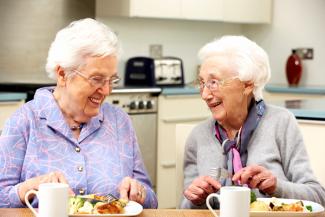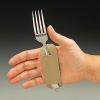
Rehabilitation specialist Lakshmi Gopalakrishnan suggests small changes around the home that make a big difference to the quality of life of the elderly.
Having worked in the rehabilitation field for more than 15 years and having been a caregiver to four elders above the age of 80, I kept coming across the need for adaptations in daily living activities. The idea is to keep the elders as independent as possible and maintain their dignity.
अब हिन्दी में पढ़ें: घर को बुजुर्गों के अनुकूल कैसे बनाएं
Here are some of the small changes that made a big difference.
Bathrooms:
Grab bars and handles:
- In front of / on both sides of the seat
- Next to shower area
Toilet seat raisers: This is an attachment available in surgical stores to raise the height of the seat. It can be easily fitted on to the existing toilet seat. Usually available in different heights of 2”,4”,6”.
Shower stool/chair:
- A sturdy plastic/waterproof stool with rubber under the legs.
- The height of the stool should be around 15"-22” depending on the height of the individual. It is important to ensure that the stool is not too low and the feet rest nicely on the floor when you sit. If the stool height is just above the knee, there is no pressure on the knee and hip while sitting and getting up
- If the person is very heavy/obese, it is better to have a sturdier metal stool with waterproof paint.
- If the person needs more support, get a chair with a back rest (plastic/metal).
Flooring: Anti-skid tiles in the bathroom are safer for all.
Buckets: If person has bucket bath, place the buckets at a height, so the elderly person doesn’t have to bend too much to take the water.
Scrubbers: A long handled soft-brush/loofah is very useful since most elders cannot reach toes and back easily. Make sure you clean the brush/loofah after use
Bedroom:
- The height of the bed should be such that when the person sits on it, he/she can rest their feet flat on the ground, and the thighs should be flat on the bed (not raised in an angle).
- The bed should not be too soft.
- A handle in front of the bed or a walker close by to help with getting up and standing.
- If the elder has rare accidents of incontinence, it is better to tuck in a rubber sheet on the lower half of the bed, under the sheet.
- A side table with an easy-to-open drawer is very useful since most elders have a lot of small items – spectacles, hearing aid, TV remotes etc - which they wish to keep within reach.
- A chair with armrests, which is stable, ie the chair doesn’t slide back when the person tries to sit or stand up from it. Otherwise, place the chair against a wall.
- A night light if it doesn’t disturb sleep
- If person sleeps alone, an electronic call bell within reach (the bell should ring within caregiver’s hearing)
Dining:
- All chairs and stools should be high enough so that elderly person can rise easily. If the seat alone can be rotated, it makes it very easy to sit and turn the chair under the table.
- Use a plate with a rim for rice eaters. A shallow bowl for runny foods. A deep spoon.
If the person has Parkinson’s, the plate should be placed closer to his mouth. For example, place the plate on a wooden box to raise its height and place a non-skid mat under the plate. You can choose a spoon with a short handle. You can add a Velcro grip, so the spoon doesn’t slip. The spoon can even be turned at an angle of 90 degrees (see second pix) so that minimal movement will bring food to mouth. Let the person rest his elbow on the table. (A cycle bar handle can be fixed to the spoon/fork and any mechanic shop will angle the spoon for you. Angle it according to the handedness of the person (left/right handed).


- Get a cup with 2 handles if required.
- Most elders prefer soft foods and low spice, but individual tastes are very important
- A handy box of tissues.
Mobility/Walking:
- If the person can walk independently without difficulty, he should do so. If the person needs support for stability, he/ she should use a walking cane for support. A four-pronged one (quadruped) will stand on its own and not keep falling down.
- If they need a walker, but find it tedious to lift it each time, get one with two front wheels and train them to use it safely. You can tie a small shallow bag/basket to the walker so that the person can carry a few things in it.
Clothes/Dressing: Individual tastes matter a lot and we should be careful not to embarrass the person.
- If buttoning is difficult, try Velcro fasteners, larger buttons or press buttons.
- Easy to pull up Trousers /track pants with elastic.
- Loose shifts/nighties. My-90-year-old aunt refused to wear anything but sarees, but was so bent that the sarees were too big. We used to remove the upper border (about 4 inches) and run a long stitch along it. Also choose sarees without any jari or fancy work as this pokes uncomfortably.
- If one side of the body is affected, dress the AFFECTED LIMB FIRST and then the other, BUT while UNDRESSING, remove dress from good limb first and then the affected limb.
- Make sure that the clothes end a little above the ankles to avoid tripping.
Speech loss and Communication: Strokes may cause loss of speech or mobility. Here are a few ideas to keep up communication:
- If the person is bedridden and can only move eyes / make sounds, see if you can make him/her blink in response to questions or to move eyes grossly left/right-for Yes/No. Give 2 choices for each question you ask.
- If person is able to use hand to touch but is not able to write, make a chart with 4 to 8 words written in large print and with a space between. Prop it up near the hand (within vision) and see if he can communicate by touching the word. Start with essential words like Yes, No, Water, Hungry, Toilet, TV, Sleep, Pain, Phone, important people in the person’s life, etc.
- If she /he can write, use a writing pad and sketch pen; or a small white board and marker.
Diapers: If the elder has developed incontinence, diapers are very useful and will give more confidence to the person, especially at night, when going out or travelling.
- There are different sizes available
- Different for male/female use.
- Different types like pull- up -pants or wrap- around –and- fasten
Related Reading: Preventing Falls for Older Adults-Indoors and Outdoors
Lakshmi Gopalakrishnan is a Special Educator and Rehabilitation specialist with 17 years of experience in the field of disability. She has worked at Vidya Sagar, an NGO that provides services for people with neurological impairments, Public Health Center and Children's Hospital. She also lectures at training courses on disability and psychology topics.






